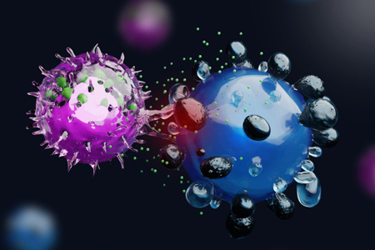Automated Isolation Of CD56+ Natural Killer Cells And Antibody-Dependent Cellular Cytotoxicity
By Innate Lymphocytes R&D team, Miltenyi Biotec and Glykos Finland Ltd.

Natural killer (NK) cells are regulated by a sophisticated system of inhibitory and stimulatory receptors, as well as comodulating receptors. NK cells are characterized by the expression of CD56 and the absence of CD3. They are able to kill target cells via direct cytotoxicity, secretion of cytokines, and antibody-dependent cellular cytotoxicity (ADCC) via CD16. CD16 expression is found in a subset of NK cells, CD56dim, and other innate immune cells.
ADCC is a mechanism mediated by NK cells that are activated by antibodies². Antibodies bind antigens on the target cell surface, which is thereby recognized by the CD16 receptor of the NK cells, lysing the target cells upon release of cytotoxic factors³.
NK cells can be directed and regulated by using highly specific antibodies that recognize cell surface markers of malignant cells with high affinity. In recent years, acknowledgement of NK cells as major players in cancer immunotherapies has continually increased.
For ADCC experiments, NK cells can be isolated from a variety of starting materials, including peripheral blood mononuclear cells (PBMCs) or directly from blood products like peripheral blood, leukoreduction system chambers (LRSCs), buffy coats, or Leukopaks®. Using the lactic acid dehydrogenase (LDH) assay, the cytotoxicity of cells can be quantified by measuring the amount of enzyme released from lysed target cells³. Likewise, a killing assay can also be measured using flow cytometry.
Explore results from using both flow cytometry and the LDH assay for the isolation of NK cells and an ADCC assay with the MultiMACS™ Cell24 Separator Plus.
Get unlimited access to:
Enter your credentials below to log in. Not yet a member of Cell & Gene? Subscribe today.
